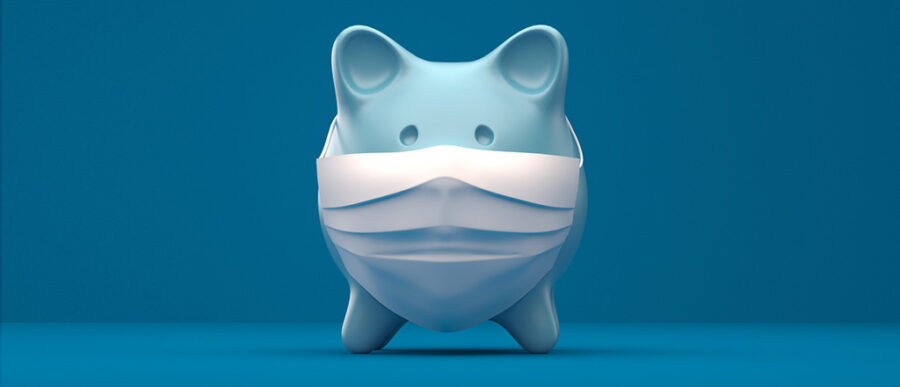President Joe Biden’s $1.9 trillion COVID relief package would lift economic growth by 0.6% this year, but that instant gratification will begin wearing off as early as 2022, according to analyses by the Penn Wharton Budget Model released last week. PWBM released three analyses of the Biden plan: a budgetary analysis of the direct aid provisions, a macroeconomic analysis of the full relief package, and a background report on the 2021 economy.
The spending included in the relief package will add to the already large federal debt, and decrease GDP by 0.2% in 2022 and 0.3% in 2040, PWBM estimated. It saw limited room to grow for the fiscal multipliers that are typically expected from large government spending, because the U.S. economy is operating at near full capacity. Similarly, the relief package will do little for job growth because the economy is already operating at near full employment, according to PWBM.
Short-term Gains, Long-term Losses
The immediate impact “is a slight uptick in GDP, [but that] is unsurprising given the huge amounts of money that are at play here,” Efraim Berkovich, PWBM’s director of computational analysis, said in an interview on the Wharton Business Daily radio show on SiriusXM. (Listen to the podcast above.) However, “the longer-term outlook is not great,” he added.
The central factor behind the underwhelming longer-term outlook is “the large amount of additional money that we’re adding to our already very large debt,” said Berkovich. “The existence of the debt saps the rest of the economy. When the government is running budget deficits, the money that could have gone to productive investment is redirected.” Not counting the Biden relief package, in the past four years, U.S. government debt held by the public increased by $7 trillion to $21.6 trillion, according to a Wall Street Journal report.
Budget deficits may be justifiable if they funded capital investment like infrastructure, according to Berkovich. “But effectively, what we’re doing is taking money from [some] people and giving it to other people for consumption purposes. That has value for social safety nets and redistributive benefits, but longer-term, you’re taking away from the capital that we need to grow our economy in the future.”
“Effectively, what we’re doing is taking money from [some] people and giving it to other people for consumption purposes.” –Efraim Berkovich
State of the Economy
Sizing up the economic impact of the pandemic, the PWBM stated in its analysis that in 2020, the U.S. economy went through “a recession of the standard type.” However, the relief measures in the CARES Act helped “in unfreezing the economy,” and it recovered to pre-COVID levels in the third quarter last year, Berkovich said. Real GDP decreased by 2.5% between the fourth quarters of 2019 and 2020, with most of the decline occurring in the second quarter of 2020, the report noted. “The economy recovered quickly in the third quarter when real GDP rose 7.5% from the quarter prior, but growth began to taper in the last quarter of 2020 with an increase of 1% from the quarter prior,” it added.
Some sectors continue to suffer, notably in-person businesses such as restaurants, hospitality and even health care to some extent. For those sectors, “the only thing you can do is wait for COVID to go away,” said Berkovich. Reopening those businesses is critical to restoring the jobs they shed because “people that are unemployed in those sectors can’t easily reallocate to the rest of the economy,” he added. “The rest of the economy doesn’t really want them to a large degree.”
Missing Multipliers
The economy would get a smaller boost from the Biden package than it did with the CARES Act, according to Berkovich. “The CARES Act provided stimulus, which was useful to unfreeze sectors of the economy — [back then], people were scared, and they were hunkered down,” he said. “But now, the multiplier effects of additional monies are going to be fairly low and muted.”
In its model, the PWBM factored in “the temporary destruction of part of the economy,” and select estimates of “fiscal multipliers” by the Congressional Budget Office that it the considered “appropriate and were closer to a full-capacity economy,” said Berkovich. “So, when you add money to an economy that’s already near capacity, you’re not going to get a lot of bang for your buck.”
The Biden plan includes features such as direct payments of $1,400 for each taxpayer, and expansion of the child tax credit and the earned income-tax credits. Those will provide a much-needed social safety net for “people in the lower-end of the income distribution who are out of work, and that money is absolutely necessary for them to survive,” said Berkovich. PWBM estimated that the direct payments, and expanding both the child tax credit and the earned income tax credit together would cost $595 billion in 2021, with 99% of households in the bottom 80% of the income spectrum receiving a benefit.
“[Direct transfers] are the most important because that’s the quickest dollars to people,” PWBM’s director of policy analysis Richard Prisinzano said in a recent Wharton Business Daily interview. The $1,400 transfers Biden proposes will be on top of $600 the treasury department began sending out in December, and $1,200 approved last March. Biden’s bill also increases weekly unemployment benefits from the $300 approved in December to $400 a week until September 2021.
However, given the way the Biden plan is structured, a sizable amount of the direct transfers will go to people in the top quintile of the income distribution, Berkovich said. “That money, in our analysis, will primarily be saved.”
As a result, according to PWBM estimates, just about 27% of stimulus checks would be spent on consumption. People would save the remainder of that money if they cannot spend it. “If you gave me another thousand dollars, I’m not going to be able to go and spend that on a spree at a restaurant, right?” said Berkovich. “So I’m going to pocket it. I’m going to put it in my bank account. I’m not going to buy a second washing machine, for instance.
“The fact that it’s going to a lot of people that really could survive very well without the money is going to generate a large amount of inflows into household savings, which is what we saw in 2020,” said Berkovich. “There’s a large increase in household savings according to the government’s own numbers.”
According to the U.S. Bureau of Economic Analysis, the U.S. personal saving rate jumped in the initial phase of the pandemic lockdowns from 12.7% in March 2020 to a record high of 32.2% in April 2020. That saving rate has since fallen to 13.7% as of December 2020.
Uninspiring Outlook for Job Growth
The Biden plan will have limited impact on job growth, according to PWBM estimates. “Broadly, the economy is near full employment with some sectors strictly idled for the near-term,” the PWBM analysis stated. “Most sectors of the economy now appear to be operating at near pre-recession levels.” It noted that unemployment has been disproportionately concentrated among lower-wage and young workers in specific sectors such as retail and leisure and hospitality. “Affected sectors are limited in recovery due to pandemic behaviors and policy restrictions, which affect both consumption and production.”
“If you gave me another thousand dollars, I’m not going to be able to go and spend that on a spree at a restaurant, right? So I’m going to pocket it. I’m going to put it in my bank account.” –Efraim Berkovich
“Most of the economy is operating at near capacity, so you’re not going to get a lot of additional hiring,” said Berkovich. “You’ll get some, but we’re nearly at where we want to be. The additional impacts of dollars [in terms of] trying to get people to go to restaurants so that people in the restaurant business can work, is just not going to happen until the economy opens up.”
The government’s tax collections for the year will of course take hits from the reduced economic activity, including wage cuts and pared work hours by businesses that stayed open during the pandemic. However, that particular can will get kicked down the road, according to Berkovich. “It doesn’t look like in the current environment people are giving too much thought to where we’re trying to fill the deficit holes – we’re just putting out debts and printing money,” he said. “Longer term, that’s an issue that has to be addressed. We’re going to have to get rid of this massive debt overhang in some manner, whether it’s by raising taxes, or maybe we’ll start to see higher inflation and devaluation of the debt.”
Clash of Views
The Biden White House did not agree with the PWBM study on the likely impact of the $1.9 trillion relief package. In a press conference, White House Press Secretary Jen Psaki responded to the PWBM analysis, specifically critiquing the idea that the economy is “near capacity.”
In response to a reporter’s question, Psaki said: “We’ve seen [the PWBM] analysis, and I’ve talked to our economic team about it, and frankly feel it’s way out of step with the majority of studies on this plan, including independent analysis from Moody’s, JPMorgan Chase and the Brookings Institution. The analysis concludes that our economy is near capacity, which would be news to the millions of Americans who are out of work or facing reduced hours and reduced paychecks. So, this starting place means their model is way off.”
Berkovich and Prisinzano rebutted the White House critique in a statement. “Throughout our analysis, we demonstrate that many sectors of the economy (particularly those related to in-person services) continue to struggle,” they wrote. “For instance, in Table 1 of our macroeconomic analysis, we calculate pandemic related unemployment by age and income, showing the large harm the recession is causing to low-income households. As our background analysis shows, many service sectors are far below pre-recession levels. However, that same analysis shows that many sectors of the economy are close to or above their pre-recession levels of consumption and production. A recent report by the Congressional Budget Office is in line with our assessment that most sectors are healing.”
Berkovich and Prisinzano added that recovery in the affected sectors is limited by pandemic-related shutdowns and individual behavior. “There is no mechanism by which additional household spending will stimulate those sectors until pandemic-related restrictions ease,” they wrote. “Additional spending in less-affected, near-capacity sectors will also not have large stimulative effects. However, the Biden plan’s relief payments would support low-income and unemployed households most affected by the pandemic.”
Republican Counterplan
A group of 10 Republican senators last week proposed a relief package that would be less than a third of the size of the $1.9 trillion Biden plan. They made a case to Biden that their smaller plan has a greater chance of securing bipartisan support in Congress. The PWBM will put out a report on that plan as well, said Berkovich.
In the coming weeks, PWBM plans to release its estimated impacts of opening up the economy and the rollout of COVID-19 vaccines. Its latest analysis assumes that the U.S. economy will stay “pretty much locked down through 2021,” said Berkovich. “If things open up three months earlier or three months later, obviously that will make a difference.”



